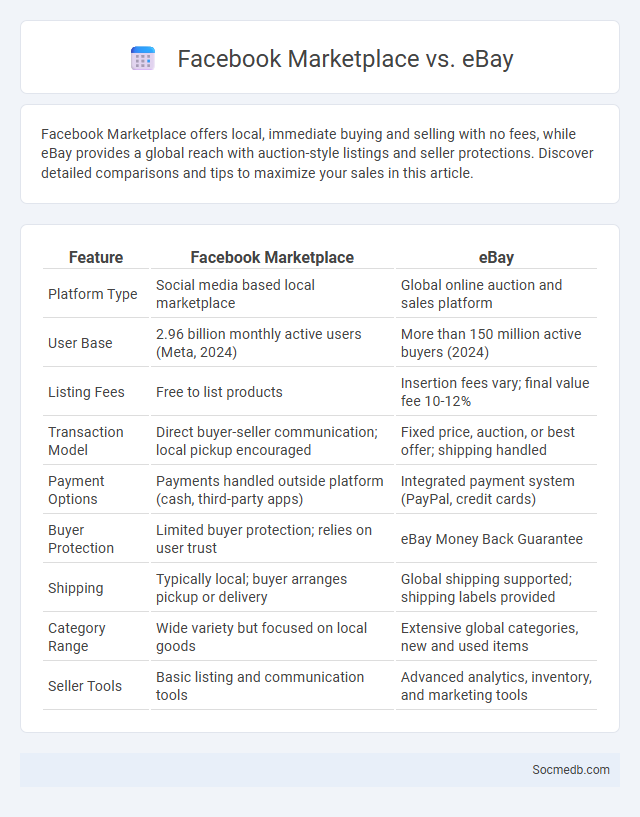
Photo illustration: Facebook Marketplace vs eBay
Facebook Marketplace offers local, immediate buying and selling with no fees, while eBay provides a global reach with auction-style listings and seller protections. Discover detailed comparisons and tips to maximize your sales in this article.
Table of Comparison
| Feature | Facebook Marketplace | eBay |
|---|---|---|
| Platform Type | Social media based local marketplace | Global online auction and sales platform |
| User Base | 2.96 billion monthly active users (Meta, 2024) | More than 150 million active buyers (2024) |
| Listing Fees | Free to list products | Insertion fees vary; final value fee 10-12% |
| Transaction Model | Direct buyer-seller communication; local pickup encouraged | Fixed price, auction, or best offer; shipping handled |
| Payment Options | Payments handled outside platform (cash, third-party apps) | Integrated payment system (PayPal, credit cards) |
| Buyer Protection | Limited buyer protection; relies on user trust | eBay Money Back Guarantee |
| Shipping | Typically local; buyer arranges pickup or delivery | Global shipping supported; shipping labels provided |
| Category Range | Wide variety but focused on local goods | Extensive global categories, new and used items |
| Seller Tools | Basic listing and communication tools | Advanced analytics, inventory, and marketing tools |
Overview of Facebook Marketplace, eBay, and Marketplace
Facebook Marketplace offers a user-friendly platform where millions of users buy and sell items locally, leveraging Facebook's vast social network for trust and convenience. eBay remains a global leader in online commerce, providing auction-style and fixed-price sales with advanced seller tools and buyer protection policies. Marketplace features on other platforms integrate social elements and secure payment systems, enhancing the peer-to-peer transaction experience.
User Demographics and Audience Reach
Social media platforms attract diverse user demographics, with age groups ranging from Gen Z to Baby Boomers, each engaging differently based on content preferences and platform features. Your ability to tailor content to specific demographics, such as targeting millennials interested in lifestyle or professionals seeking industry news on LinkedIn, significantly enhances audience reach. Understanding these demographic insights enables more precise marketing strategies, increasing engagement and expanding your social media presence effectively.
Listing and Selling Process Comparison
Social media platforms streamline the listing and selling process by offering direct communication channels, audience targeting, and integrated payment systems that differ significantly between platforms such as Facebook Marketplace, Instagram Shopping, and Etsy. Your experience varies depending on user interface simplicity, transaction security, and marketing tools available, which influence how quickly and effectively you can reach potential buyers. Optimizing your listing with clear descriptions, high-quality images, and strategic hashtags can enhance visibility and expedite the selling process.
Fees and Pricing Structures
Social media platforms typically generate revenue through various fees and pricing structures, including advertising costs, subscription plans, and in-app purchases. Advertising fees are often based on cost-per-click (CPC) or cost-per-impression (CPM) models, allowing businesses to target specific audiences efficiently. Understanding these pricing mechanisms helps you optimize your marketing budget and maximize return on investment across different social networks.
Payment Methods and Security
Secure payment methods on social media platforms protect your financial information by using encryption technologies such as SSL and tokenization. Popular platforms offer multiple payment options including credit/debit cards, digital wallets like PayPal and Apple Pay, and direct bank transfers, ensuring convenience and safety. Monitoring transaction history and enabling multi-factor authentication further enhance the security of your social media payments.
Shipping, Delivery, and Local Pickup Options
Social media platforms are essential for promoting your shipping, delivery, and local pickup options, enabling you to reach a wider audience with timely updates. Highlighting real-time tracking, estimated delivery times, and flexible pickup points increases customer satisfaction and encourages repeat business. Effective use of targeted ads and customer reviews on social media boosts trust and drives conversions.
Buyer and Seller Protection Policies
Social media platforms implement robust Buyer and Seller Protection Policies to enhance trust and secure transactions within their marketplaces. These policies typically include mechanisms such as dispute resolution, refund guarantees, and seller verification processes to minimize fraud and ensure accountability. By enforcing these protections, social media marketplaces foster a safer environment for users to engage in commerce confidently.
Types of Products and Categories Allowed
Social media platforms typically allow a variety of product types including physical goods, digital products, services, and subscription-based offerings. Categories commonly permitted range from fashion, electronics, and beauty products to educational courses, software, and fitness programs. Your marketing strategy should align with each platform's specific policies to ensure compliance and maximize reach.
Pros and Cons of Each Platform
Facebook offers extensive reach with diverse demographic targeting and robust advertising tools but struggles with privacy concerns and declining engagement among younger users. Instagram excels in visual storytelling and influencer marketing yet faces criticism for promoting unrealistic beauty standards and algorithm-driven content visibility. Twitter enables real-time news sharing and public discourse but often deals with misinformation, harassment, and limited character count impacting nuanced communication.
Choosing the Best Platform for Your Needs
Selecting the optimal social media platform depends on your target audience, content type, and engagement goals. Platforms like Instagram and TikTok excel in visual storytelling for younger demographics, while LinkedIn targets professionals and B2B connections effectively. Analyzing platform analytics and user behavior ensures alignment with your brand's objectives and maximizes reach and interaction.
 socmedb.com
socmedb.com